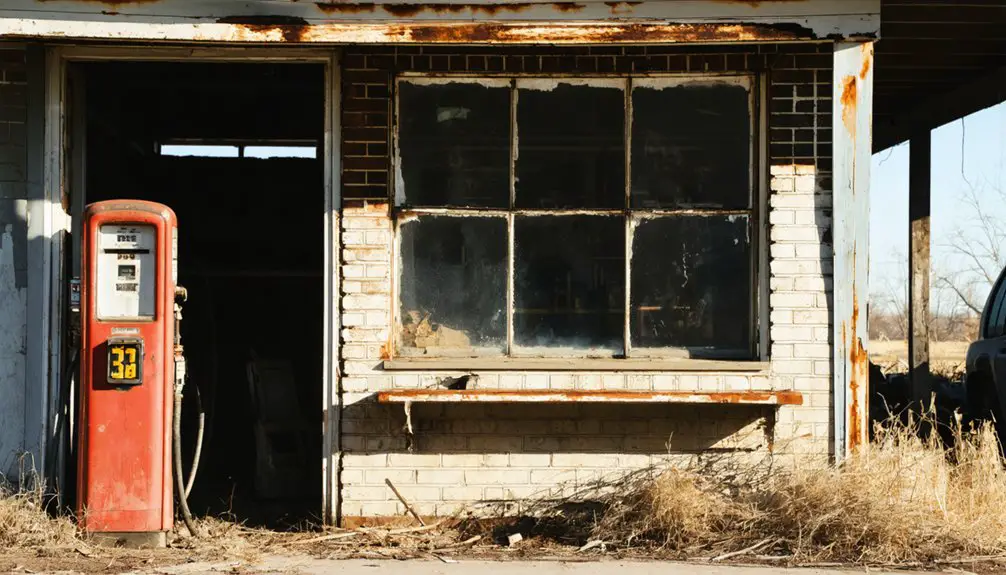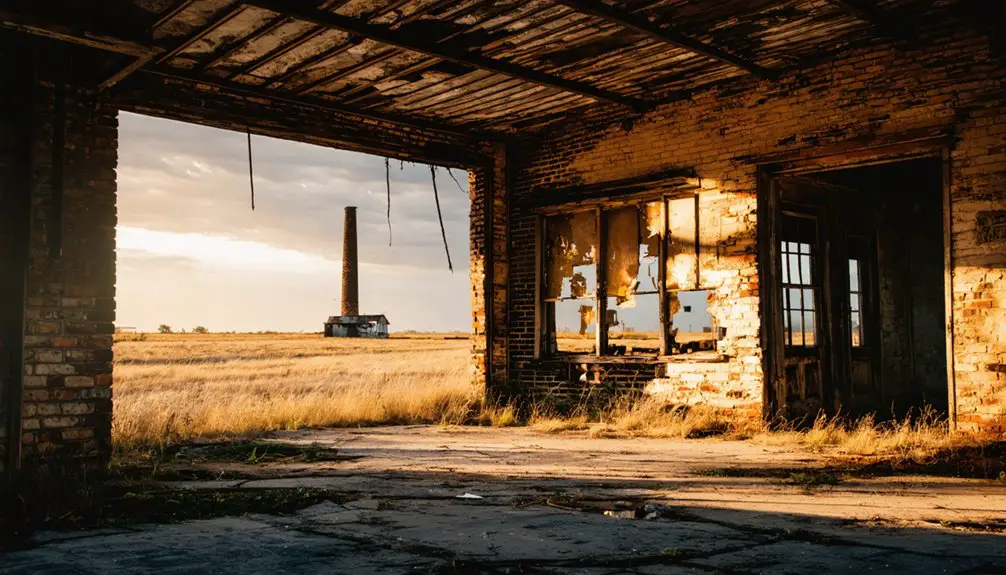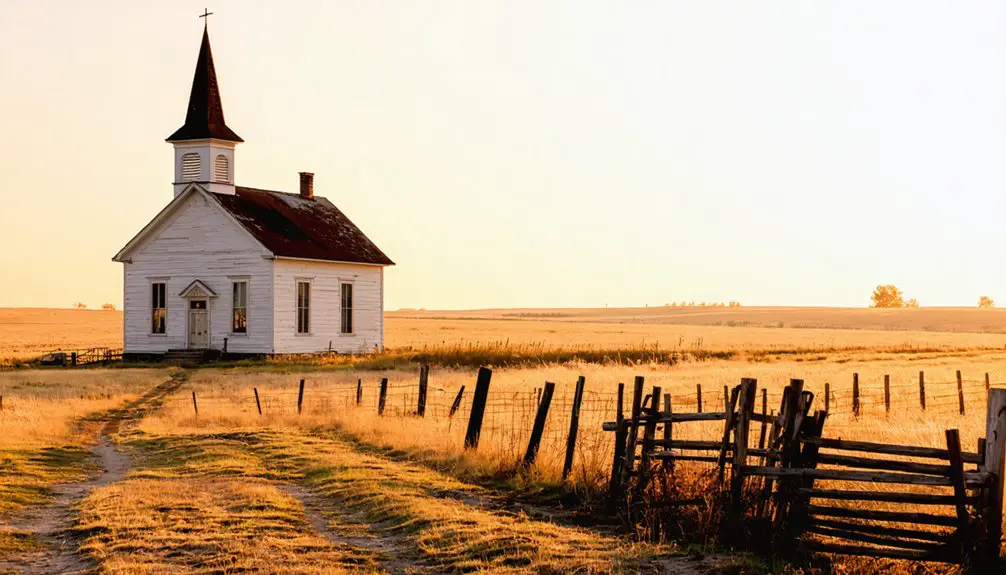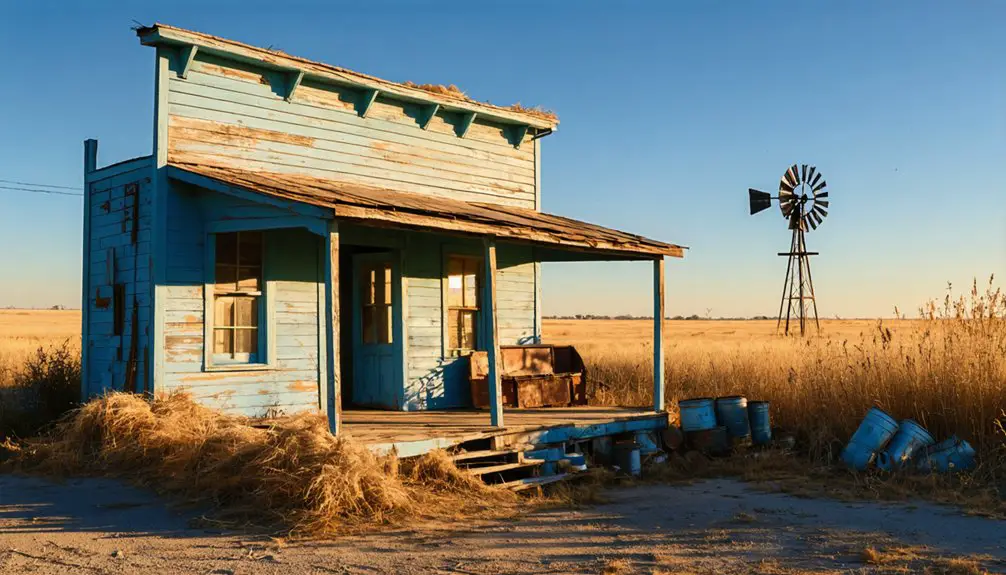You’ll find Hope, Oklahoma nestled in Stephens County, about 9 miles northeast of Duncan near Clear Creek. This former agricultural and railway hub emerged during Oklahoma’s late 19th-century expansion, thriving through farming, trade, and strategic rail connections. Its decline began with changing transportation patterns and the rise of Route 66 in 1926. Today, dense oak forests and thick underbrush reclaim the remnants, while Griffin Memorial Hope Hall stands as the most significant surviving structure.
Key Takeaways
- Hope was an Oklahoma boomtown that declined after changes in railroad routes and the emergence of Route 66 in 1926.
- Located in Stephens County, 9 miles northeast of Duncan, the ghost town sits in dense woodland near Clear Creek.
- The community once thrived with a church, schoolhouse, and general store serving as social anchors for residents.
- The Griffin Memorial Hope Hall, built in 1928, remains the most prominent structure but is closed to public access.
- The town’s collapse followed typical patterns of early 20th-century American communities dependent on single industries like mining.
The Rise and Fall of a Forgotten Community
While many Oklahoma towns established in the late 19th and early 20th centuries experienced dramatic growth, Hope emerged during a period of agricultural expansion that typified the region’s development. The discovery of natural resources in the area initially fueled the town’s formation, similar to thousands of other Oklahoma boomtowns.
Hope’s origins reflect Oklahoma’s broader agricultural boom, emerging alongside countless prairie towns during the territory’s expansion years.
You’ll find its story woven into local folklore, as the town initially prospered through farming and trade, bolstered by strategic railway connections that brought energy to the community. The arrival of Mother Road travelers brought temporary vitality to local businesses, mirroring the pattern seen across Route 66 communities.
The cultural impact of Oklahoma’s 1907 statehood reshaped Hope’s social fabric, but it’s the shifting transportation patterns that sealed the town’s fate.
When Route 66 emerged in 1926, it promised prosperity but ultimately contributed to Hope’s decline. As newer highways bypassed the area, you’d have witnessed the gradual exodus of businesses and residents, transforming a once-bustling community into another example to Oklahoma’s boom-and-bust cycles.
Geographic Location and Natural Setting
You’ll find Hope’s rugged terrain and wooded landscape nestled in Stephens County, approximately 9 miles northeast of Duncan near Clear Creek.
The ghost town’s remote location, marked by coordinates 34.5945°N and 97.6864°W, sits among a mix of prairie and woodland that typifies south-central Oklahoma’s natural environment. Like the abandoned Griggs church, remnants of early settlement still dot the landscape. The area experiences harsh seasonal extremes, with cold, snowy winters and hot, dry summers.
While Plato Road provides the main access route from Duncan, you’ll need to navigate less-maintained 4WD paths to reach this secluded site, where the surrounding rough terrain has helped preserve its isolated character.
Regional Terrain Features
Nestled in Stephens County, Oklahoma, the ghost town of Hope sits approximately 9-10 miles northeast of Duncan city, near the intersection of Plato Road and Clear Creek.
You’ll find yourself maneuvering through very rough, heavily wooded terrain that’s made exploration challenging for even the most determined adventurers. Like many Route 66 ghost towns, the site stands frozen in time, a testament to America’s changing landscape.
The area’s ecological diversity reflects Oklahoma’s distinctive shift zone between prairie and woodland. You’re surrounded by dense oak and hickory forests, with thick underbrush that’s reclaimed many of the town’s original structures. Similar to towns like Boggy Depot, only scattered stone foundations remain visible through the vegetation.
The terrain challenges include variable climate conditions, from snow-laden winters to scorching summers typical of south-central Oklahoma.
Clear Creek’s presence has shaped the local riparian habitat, creating a dynamic landscape where nature’s gradually erasing traces of human settlement.
County Border Placement
Located well within Stephens County’s interior, Hope stands distinctly apart from Oklahoma’s border settlements. You’ll find it about 9-10 miles northeast of Duncan, positioned in a region where county border significance played little role in its development or decline.
Unlike ghost towns such as Texola that emerged along county lines, Hope’s placement reflects more practical considerations of local geography and resources. Similar to how toxic mine waste forced residents to abandon Picher, environmental factors shaped settlement patterns in this region.
The county dynamics surrounding Hope are straightforward – while Stephens County shares boundaries with Grady, Jefferson, Carter, and Garvin counties, Hope’s location keeps it removed from these administrative borders.
Instead, you’ll discover its position was more influenced by Clear Creek’s water access and the rural road network connecting it to Duncan and nearby farming communities.
Transportation Route Access
While many Oklahoma ghost towns developed along major transportation routes, Hope’s position presented significant access challenges from its earliest days.
You’ll find the former settlement roughly 9-10 miles northeast of Duncan, situated in dense woodland with particularly rough terrain.
If you’re planning to explore the site today, you’ll need to prepare for off-road access conditions. The main approach follows Plato Road east from Duncan, but don’t expect well-maintained paths.
Trail navigation becomes particularly challenging due to the heavily forested landscape and uneven ground. Unlike ghost towns that sprouted along railroad lines, Hope remained isolated from major transport infrastructure. This isolation was common in many of Oklahoma’s 240+ towns that eventually became abandoned.
The absence of rail service and limited road development likely contributed to the town’s eventual abandonment, as residents faced ongoing difficulties with transportation and trade connections.
Early Settlement and Town Origins
During the late 19th century’s land openings in Oklahoma Territory, Hope emerged as one of many rapidly established settlements following the government’s release of Native American reservation lands.
Like other towns born during the land rush era, you’d have witnessed Hope’s swift evolution from open prairie to a bustling community, with settlers racing on foot to stake their claims within the townsite.
In those early days, you’d have seen a mix of temporary shelters and tents dotting the landscape as Hope’s town identity took shape. Similar to towns like Moral and Corner, Hope’s development reflected the moral and economic tensions of frontier settlements.
The population quickly grew to over 3,000 people as the town established itself in the region.
The settlement reflected the broader patterns of Oklahoma’s territorial progression, where communities sprang up virtually overnight.
Saloons, grocery stores, and other businesses quickly established themselves as settlers sought to build a new life on the frontier.
Economic Foundations and Local Industries

The rich deposits of lead and zinc in the Tri-State Mining District shaped Hope’s economic destiny from its earliest days.
You’ll find that Hope’s mining legacy played an essential role in America’s military efforts, providing nearly half the lead used for bullets during both World Wars. The town thrived with a network of supporting businesses, including smelters and supply stores that served the mining community‘s needs.
But Hope’s community resilience would be tested as the mining industry began its decline by the mid-20th century.
When the mines closed in 1967, the town’s economic foundation crumbled. Environmental challenges from abandoned mines, including sinkholes and contamination, eventually led to the area’s designation as a Superfund site, marking the end of Hope’s industrial era.
Daily Life in Historic Hope
If you’d visited Hope during its heyday, you’d have found a vibrant community centered around the local church and schoolhouse, where residents gathered regularly for religious services, town meetings, and social events like dances and fairs.
You’d have noticed the critical role of Hope’s general store as both a trading hub and social anchor, where townsfolk exchanged goods, shared news, and collected mail from surrounding communities.
The town’s location along established trade routes connected residents to larger markets, while the one-room schoolhouse provided basic education to local children and served as a cornerstone of community life.
Commerce and Trade Routes
As commerce flowed through the small trading post of Hope, Oklahoma, local farmers and ranchers relied on the town’s general stores and mercantile businesses for their essential needs.
You’d find barter systems thriving as residents exchanged their crops and livestock for manufactured goods, while trading practices centered on trust and community relationships.
Without a railroad connection, Hope’s merchants depended on horse-drawn wagons and early automobiles to transport goods along local roads linking to larger towns.
You would’ve seen the daily buzz of activity as farmers brought their wheat, corn, and cotton to trade, while craftsmen offered services like blacksmithing and carpentry.
The general stores served as both economic hubs and social gathering spots, though the lack of rail access ultimately stunted the town’s growth and contributed to its decline.
Community Social Activities
Life in historic Hope revolved around vibrant community gatherings that wove together the social fabric of this small Oklahoma town. You’d find folks congregating at the local dance halls, where weekend gatherings brought families together for lively evenings of music and socializing.
Community potlucks at neighbors’ homes and church socials strengthened bonds between residents, while seasonal harvest celebrations united the town in shared labor and festivity.
The post office and general store served as impromptu meeting spots where you’d catch up on local news and share stories. Children played freely outdoors, creating their own entertainment, while women organized quilting bees and men gathered for hunting expeditions.
These daily interactions and celebrations created a tight-knit community where mutual support and cooperation defined daily life.
Religious and Educational Life
Religious and educational institutions formed the bedrock of Hope’s social structure, with churches and the local schoolhouse serving as cornerstones of daily life. You’d find Protestant churches hosting weekly services and religious gatherings that brought the community together, while the town’s schoolhouse educated local children according to agricultural schedules.
- Women played essential roles through educational outreach, leading church activities, and teaching at the schoolhouse.
- The school curriculum focused on fundamental skills like reading and arithmetic, while incorporating moral teachings that aligned with church values.
- Both institutions served multiple purposes, with churches doubling as town meeting spaces and the school functioning as a hub for civic engagement.
These pillars of community life helped shape Hope’s identity until economic changes and population shifts led to their eventual decline.
Transportation Networks and Accessibility
Through its strategic position along essential railroad lines connecting Oklahoma to Kansas, Hope once thrived as a bustling transit point for agricultural goods and travelers.
You’ll find evidence of this transportation evolution in the abandoned tracks that still mark the landscape, remnants of a crucial network that once linked Hope to Burton, Hopkins, and other regional stops.
The town’s accessibility challenges multiplied when modern highways redirected traffic away from these rural corridors.
While Route 66 initially offered promise to nearby communities, the Interstate Highway System‘s development left towns like Hope increasingly isolated.
As rail service declined and road networks bypassed the area, farmers struggled to move their crops to market efficiently.
This shift in transportation patterns ultimately contributed to Hope’s transformation from a connected community to a ghost town.
Factors Leading to Abandonment

You’ll find that Hope’s decline began with major economic setbacks when the railroad company shifted its routes away from the town in the early 1900s.
The loss of rail service devastated Hope’s commercial prospects, forcing local businesses to shutter their doors and cutting off essential transportation links for agriculture and trade.
As jobs disappeared and economic opportunities dwindled, Hope’s residents left en masse, reducing the once-thriving community to little more than scattered ruins and abandoned buildings.
Economic Downturn and Closure
The economic collapse of Hope, Oklahoma mirrors the familiar pattern of many oil boomtowns that flourished and failed in early 20th-century America. The town’s economic instability became evident as oil production declined, revealing the dangers of depending too heavily on a single industry.
Despite attempts at community resilience, Hope couldn’t overcome the perfect storm of economic challenges that sealed its fate.
- The oil bust triggered a cascade of closures – first the oil operations, then local businesses, and finally essential services like the post office.
- Agricultural mechanization reduced farming jobs while changes in market conditions made small-scale farming less viable.
- The Great Depression dealt a devastating blow, causing mass exodus as residents sought opportunities in larger cities.
Railroad Route Changes
While Hope’s initial prosperity relied heavily on its strategic railroad location, shifting transportation patterns in the mid-20th century drastically altered the town’s connectivity and economic prospects.
The Rock Island Railroad‘s branch line that served Hope originally promised greater railroad expansion westward to Waurika, but those plans never materialized.
You’ll find that when automobiles and improved highways emerged as the dominant transportation method, the railroad’s importance diminished considerably.
The Rock Island struggled with profitability along this route, and corporate decisions to consolidate operations led to eventual abandonment.
Like many small Oklahoma towns, Hope’s fate was sealed when the railroad companies redirected their focus to main lines, leaving branch routes to wither as truck transport took over freight services.
Population Mass Exodus
Several devastating factors converged to trigger Hope’s mass exodus, transforming this once-vibrant community into a ghost town.
You’ll find that population decline accelerated as the town faced multiple challenges that tested its community resilience.
- When natural resources were depleted, jobs vanished rapidly, forcing residents to seek employment elsewhere – a common pattern you’d see across Oklahoma’s estimated 2,000 ghost towns.
- The closure of essential services, including schools and community centers, made it increasingly difficult for families to maintain their quality of life.
- Natural disasters struck devastating blows to the town’s infrastructure, and without sufficient resources to rebuild, many residents couldn’t justify staying in an area with diminishing opportunities and growing safety concerns.
Remaining Structures and Ruins Today

Among Hope’s few surviving structures, Griffin Memorial Hope Hall stands as the most prominent remnant of this Oklahoma ghost town. Built in 1928, this historic architecture served as a mental health facility until its closure in 2012, housing both civilian patients and veterans seeking PTSD treatment.
Today, you’ll find the site heavily monitored and closed to public access, presenting significant preservation challenges for this institutional landmark.
Unlike typical ghost towns that feature abandoned storefronts, saloons, or residential ruins, Hope’s remaining footprint centers almost exclusively on its medical facilities.
While Griffin Memorial Hope Hall remains structurally sound, its future remains uncertain without definitive preservation plans. The building’s restricted access and institutional character set it apart from Oklahoma’s more commonly explored ghost towns.
Notable Events and Local Stories
Hope’s troubled past reveals dark episodes that shaped Oklahoma’s territorial history.
Like many frontier settlements, the town became entangled in the violent disputes and lawlessness that characterized the region’s early days. Cultural significance emerged through the town’s connection to Oklahoma’s complex relationship with prohibition and liquor trade regulations.
- You’ll find haunted legends tied to the devastating economic shifts that plagued many Oklahoma towns, as Hope struggled between boom and bust cycles.
- The town’s strategic location made it a witness to territorial conflicts similar to the infamous Hay Meadow Massacre nearby.
- During prohibition, you’d have seen the town transform as it dealt with the tensions between “moral” communities and the profitable liquor trade that sustained many border settlements.
Legacy in Oklahoma’s Ghost Town Heritage

When examining Oklahoma’s ghost town heritage, you’ll discover that Hope stands among roughly 2,000 abandoned settlements that tell a larger story of the state’s dramatic boom-and-bust cycles.
Like many of its counterparts, Hope’s legacy reflects the broader cultural significance of these lost communities, where churches, schools, and community centers once showcased the social fabric of frontier life.
You’ll find that Oklahoma’s ghost towns serve as powerful reminders of how economic shifts and infrastructure changes could rapidly transform thriving communities into historical footnotes.
While some towns left lasting environmental impact through mining or industrial activities, Hope’s story adds to our understanding of how settlement patterns evolved, economic fortunes shifted, and communities adapted or disappeared in response to changing times.
Frequently Asked Questions
Are There Any Documented Paranormal Activities or Ghost Sightings in Hope?
You won’t find documented ghostly encounters or spectral evidence in Hope – research shows no verified paranormal activity. Unlike other Oklahoma ghost towns, there aren’t any officially recorded supernatural sightings here.
Can Visitors Legally Explore or Metal Detect in Hope’s Ruins?
You’ll need landowner permission before exploring or metal detecting – it’s essential for legal compliance. Verify property ownership through local records and follow state regulations to avoid trespassing violations.
What Happened to the Cemetery and Burial Records From Hope?
You’ll find Hope’s cemetery lacks active preservation, with burial records likely lost over time. While McIntosh County has some documentation, most graves remain undocumented due to decades of rural neglect.
Did Any Famous Outlaws or Historical Figures Ever Visit Hope?
Like tumbleweeds that left no trace, you won’t find any documented outlaw history or famous visitors in Hope’s story. Historical records don’t show any notable figures ever stopping in this small town.
Are There Any Surviving Photographs of Hope During Its Active Years?
Despite extensive archival research, you won’t find any confirmed surviving photographs of Hope during its active years. Historic preservation efforts haven’t uncovered any images in Oklahoma Historical Society collections or local archives.
References
- https://en.wikipedia.org/wiki/List_of_ghost_towns_in_Oklahoma
- https://www.youtube.com/watch?v=-jYN1_E2VV0
- https://www.okhistory.org/publications/enc/entry?entry=GH002
- https://quirkytravelguy.com/visiting-picher-oklahoma-ghost-town-toxic-waste/
- https://the405voyager.com/5-ghost-towns-in-oklahoma-that-will-give-you-the-creeps/
- https://www.youtube.com/watch?v=dAz-Wx_DWqs
- https://www.okhistory.org/publications/ml/january2014.pdf
- https://www.youtube.com/watch?v=DJf8D_7H45s
- https://kellycodetectors.com/content/pdf/site_locator_books/OK.pdf
- https://www.youtube.com/watch?v=zTKa5i1czdE



